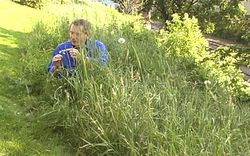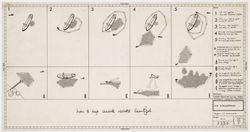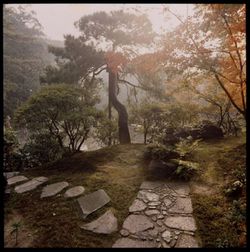Project
AP056.S1.1994.PR07
Description:
This project series documents the offices of Gluskin Sheff and Associates Inc. in Toronto from 1994-1995. The office identified the project number as 9416. Located on the 46th floor of BCE Place on Wellington Street, the offices were shaped like two conjoined octagons and were conceived as a mix of open and closed office spaces. Beech wood, panoramic views and curved lines created serenity in an attempt to offset the high-energy of daily investment activity. Similarly, custom-curved furnishings such as the trading desk added organic forms to the office environment. Sandblasted glass screens were used throughout the office to create transparency, while clear glass created openness in enclosed spaces.[1] This project was led by Marianne McKenna and Bruce Kuwabara. The project is recorded through drawings, textual records and a project model dating from 1994-1995. The drawings are mostly originals and include sketches, model and presentation drawings, plans, elevations, perspectives, drawings of custom furnishings and construction drawings. The textual records consist of a staffing schedule. [1]Bruce Kuwabara et al., Kuwabara, Payne, McKenna, Blumberg (Gloucester, MA: Rockport Publ., 1998), 120-127.
1994-1995
Gluskin Sheff and Associates Inc., Toronto (1994-1995)
Actions:
AP056.S1.1994.PR07
Description:
This project series documents the offices of Gluskin Sheff and Associates Inc. in Toronto from 1994-1995. The office identified the project number as 9416. Located on the 46th floor of BCE Place on Wellington Street, the offices were shaped like two conjoined octagons and were conceived as a mix of open and closed office spaces. Beech wood, panoramic views and curved lines created serenity in an attempt to offset the high-energy of daily investment activity. Similarly, custom-curved furnishings such as the trading desk added organic forms to the office environment. Sandblasted glass screens were used throughout the office to create transparency, while clear glass created openness in enclosed spaces.[1] This project was led by Marianne McKenna and Bruce Kuwabara. The project is recorded through drawings, textual records and a project model dating from 1994-1995. The drawings are mostly originals and include sketches, model and presentation drawings, plans, elevations, perspectives, drawings of custom furnishings and construction drawings. The textual records consist of a staffing schedule. [1]Bruce Kuwabara et al., Kuwabara, Payne, McKenna, Blumberg (Gloucester, MA: Rockport Publ., 1998), 120-127.
Project
1994-1995
Project
AP207.S1.1973.PR03
Description:
The project series documents "Spazio Vuoto Riservato A Gianni Pettena", an installation that consists of a banner with the words "Spazio Vuoto Riservato A Gianni Pettena". The first version of the banner dates from 1973, but it was initially used for the exhibition "Contribution" in Rennes in 2008, where Pettena, one of the artists invited to carry out interventions in symbolic locations around the city, chose to install his banner inside the market. The banner was used also in Pettena's solo exhibition at the Galerie Mercier & Associés, in Paris in 2011, and again at the Spazio MEGA in Milan, in 2017. "Pettena not only introduced the artistic intervention into an environment that was alien to it, but extended the provocation to the point of laying claim to absolute freedom for the artist." [1] The project series contains a sign with the words "Spazio Vuoto Riservato A Gianni Pettena", possibly the sign designed in 1973, photographs of the second edition in Rennes, photographs of the third edition of the installation at the Galerie Mercier et Associés, and photographs of the fourth edition of the installation at the Spazio MEGA. Source: [1] Gianni Pettena website, https://www.giannipettena.it/italiano/opere-1/inst-empty-space-2008/ (last accessed 12 November 2019).
1973-2017
Spazio Vuoto Riservato A Gianni Pettena [Empty Space Reserved for Gianni Pettena] (1973)
Actions:
AP207.S1.1973.PR03
Description:
The project series documents "Spazio Vuoto Riservato A Gianni Pettena", an installation that consists of a banner with the words "Spazio Vuoto Riservato A Gianni Pettena". The first version of the banner dates from 1973, but it was initially used for the exhibition "Contribution" in Rennes in 2008, where Pettena, one of the artists invited to carry out interventions in symbolic locations around the city, chose to install his banner inside the market. The banner was used also in Pettena's solo exhibition at the Galerie Mercier & Associés, in Paris in 2011, and again at the Spazio MEGA in Milan, in 2017. "Pettena not only introduced the artistic intervention into an environment that was alien to it, but extended the provocation to the point of laying claim to absolute freedom for the artist." [1] The project series contains a sign with the words "Spazio Vuoto Riservato A Gianni Pettena", possibly the sign designed in 1973, photographs of the second edition in Rennes, photographs of the third edition of the installation at the Galerie Mercier et Associés, and photographs of the fourth edition of the installation at the Spazio MEGA. Source: [1] Gianni Pettena website, https://www.giannipettena.it/italiano/opere-1/inst-empty-space-2008/ (last accessed 12 November 2019).
Project
1973-2017
Project
AP207.S1.2014.PR01
Description:
The project series documents the installation "Architettura "Correta"" designed by Pettena for the exhibition "Soleil Politique" at the Museion in Bolzano, in 2014. The project was a design for a new museum entrance. The installation was made of three glass walls on which were drawn facade details of three historical buildings of the city. The central glass wall represents the entrance from the Piacentini square in Bolzano, with, at its left, a ‘serlian’ arch, and, at its right, a detail of the portico of a ‘Piazza d’Italia’ by Giorgio de Chirico. The idea was to "connect the museum to the city’s history, an architectural element was chosen, one which, in addition to favoring the idea of ‘entrance’ to the exhibit also permitted a view both of the urban and the natural setting, the sky, the mountains, an environment typical of the area in which the city itself rises." [1] The project series contains a sketch and a spiral bound volume with correspondence between Pettena and Pierre Bal Blanc, curator of the exhibitions, and proposals for the installation. The project series also contains photographs of the installation, including printouts. Source: [1] Gianni Pettena website, https://www.giannipettena.it/italiano/opere-1/inst-revised-architecture-2014/ (last accessed 27 January 2020)
2014-2015
Architettura "Correta" ["Revised" Architecture] (2014)
Actions:
AP207.S1.2014.PR01
Description:
The project series documents the installation "Architettura "Correta"" designed by Pettena for the exhibition "Soleil Politique" at the Museion in Bolzano, in 2014. The project was a design for a new museum entrance. The installation was made of three glass walls on which were drawn facade details of three historical buildings of the city. The central glass wall represents the entrance from the Piacentini square in Bolzano, with, at its left, a ‘serlian’ arch, and, at its right, a detail of the portico of a ‘Piazza d’Italia’ by Giorgio de Chirico. The idea was to "connect the museum to the city’s history, an architectural element was chosen, one which, in addition to favoring the idea of ‘entrance’ to the exhibit also permitted a view both of the urban and the natural setting, the sky, the mountains, an environment typical of the area in which the city itself rises." [1] The project series contains a sketch and a spiral bound volume with correspondence between Pettena and Pierre Bal Blanc, curator of the exhibitions, and proposals for the installation. The project series also contains photographs of the installation, including printouts. Source: [1] Gianni Pettena website, https://www.giannipettena.it/italiano/opere-1/inst-revised-architecture-2014/ (last accessed 27 January 2020)
Project
2014-2015
archives
Level of archival description:
Fonds
AP198
Synopsis:
The Kivi Sotamaa OCEAN North project records, 1997-2000, consist of born-digital files, drawings, photographs, and physical models that document two projects by the OCEAN North collective: Jyväskylä Music and Arts Centre (competition, 1997) and Tölöö Football Stadium (competition, 1997). The archive also includes born-digital reference materials on 14 projects from the collective, including the two projects mentioned above.
1997-2000
Kivi Sotamaa OCEAN North project records
Actions:
AP198
Synopsis:
The Kivi Sotamaa OCEAN North project records, 1997-2000, consist of born-digital files, drawings, photographs, and physical models that document two projects by the OCEAN North collective: Jyväskylä Music and Arts Centre (competition, 1997) and Tölöö Football Stadium (competition, 1997). The archive also includes born-digital reference materials on 14 projects from the collective, including the two projects mentioned above.
archives
Level of archival description:
Fonds
1997-2000
Sub-series
Drawings and scripts
AP165.S7.SS1
Description:
The Drawings and scripts sub-series, 1980 – 2000, consists of 2538 digital files (2 GB) that document Hoberman’s work in AutoCAD to create his patented transformable designs. The majority of records are AutoCAD drawing files and AutoLISP scripts, dating from the mid to late 1990s. Drawings in the sub-series comprise a variety of Hoberman’s expanding installations, toy products and architectural structures, as well as a series of industrial patents and production drawings that detail the manufacturing and assembly of parts. AutoLISP scripts included in the sub-series were written and used by Hoberman for customized command within the AutoCAD environment as the in-program language. These scripts allowed Hoberman to solve the complex mathematical and geometrical calculations necessary to control the design and engineering of each component of his structures. Notable projects include: Iris Dome at Expo 2000 World's Fair, Hanover (2000); Expanding Hypar at California Science Center, Los Angeles (1998); Expanding Helicoid at Inventor's Hall of Fame, Akron (1998); Expanding Fabric Dome at Centre Georges Pompidou, Paris (1997); Iris Dome at Museum of Modern Art, New York (1994); Geodesic Sphere at Technorama der Shweiz, Winterthur (1993); and Expanding Sphere at Liberty Science Center, Jersey City (1991).
1980 - 2000
Drawings and scripts
Actions:
AP165.S7.SS1
Description:
The Drawings and scripts sub-series, 1980 – 2000, consists of 2538 digital files (2 GB) that document Hoberman’s work in AutoCAD to create his patented transformable designs. The majority of records are AutoCAD drawing files and AutoLISP scripts, dating from the mid to late 1990s. Drawings in the sub-series comprise a variety of Hoberman’s expanding installations, toy products and architectural structures, as well as a series of industrial patents and production drawings that detail the manufacturing and assembly of parts. AutoLISP scripts included in the sub-series were written and used by Hoberman for customized command within the AutoCAD environment as the in-program language. These scripts allowed Hoberman to solve the complex mathematical and geometrical calculations necessary to control the design and engineering of each component of his structures. Notable projects include: Iris Dome at Expo 2000 World's Fair, Hanover (2000); Expanding Hypar at California Science Center, Los Angeles (1998); Expanding Helicoid at Inventor's Hall of Fame, Akron (1998); Expanding Fabric Dome at Centre Georges Pompidou, Paris (1997); Iris Dome at Museum of Modern Art, New York (1994); Geodesic Sphere at Technorama der Shweiz, Winterthur (1993); and Expanding Sphere at Liberty Science Center, Jersey City (1991).
Sub-series 1
1980 - 2000
articles
The planet is the client
Environmental Histories
To kick off “Architecture and/for the Environment” —the CCA’s third Multidisciplinary Research Project funded by the Andrew W. Mellon Foundation—Daniel Abramson and Imre Szeman will present two key concepts that reconceive the environment in the history of architecture. Daniel Abramson, an architectural historian, will discuss how the idea of architectural “obsolescence”(...)
Paul Desmarais Theatre
15 December 2016, 6pm
Environmental Histories
Actions:
Description:
To kick off “Architecture and/for the Environment” —the CCA’s third Multidisciplinary Research Project funded by the Andrew W. Mellon Foundation—Daniel Abramson and Imre Szeman will present two key concepts that reconceive the environment in the history of architecture. Daniel Abramson, an architectural historian, will discuss how the idea of architectural “obsolescence”(...)
Paul Desmarais Theatre
textual records
AP206.S2.074
Description:
File was originally housed in a binder along with content arranged in AP206.S2.072 and AP206.S2.073. This file includes the following papers: "Le Corbusier's Chandigarh: Architecture in the Cultural Context," symposium talk, 1990 "Why not Ruralisation," paper outline "Growing Problems of Cities," book review of "The Politics of Urban Redevelopment: A Study of Old Delhi by Ajay K. Mehra," 1991 "Housing as Consumer Commodity," book review of "Housing and Urbanisation: A Study of India by Cedric Pugh," 1991 "Air Pollution and Conservation of the Environment," speech
1986-1998
Published and unpublished papers (folder 3 of 3)
Actions:
AP206.S2.074
Description:
File was originally housed in a binder along with content arranged in AP206.S2.072 and AP206.S2.073. This file includes the following papers: "Le Corbusier's Chandigarh: Architecture in the Cultural Context," symposium talk, 1990 "Why not Ruralisation," paper outline "Growing Problems of Cities," book review of "The Politics of Urban Redevelopment: A Study of Old Delhi by Ajay K. Mehra," 1991 "Housing as Consumer Commodity," book review of "Housing and Urbanisation: A Study of India by Cedric Pugh," 1991 "Air Pollution and Conservation of the Environment," speech
textual records
1986-1998
Being There examines Arthur Erickson’s exchanges with people, places, landscapes, buildings, rituals, and ideas during his early travels in Europe and North Africa between 1950 and 1952, and in Asia in 1961. Drawing on a prescient understanding of site and environment, Erickson was convinced that architecture must be experienced to be understood. He knew that travel and(...)
15 November 2024 to 30 March 2025
Being There: Photography in Arthur Erickson’s Early Travel Diaries
Actions:
Description:
Being There examines Arthur Erickson’s exchanges with people, places, landscapes, buildings, rituals, and ideas during his early travels in Europe and North Africa between 1950 and 1952, and in Asia in 1961. Drawing on a prescient understanding of site and environment, Erickson was convinced that architecture must be experienced to be understood. He knew that travel and(...)
Project
AP140.S2.SS1.D99
Description:
File documents an executed project for the Lowry Centre in Salford, England, United Kingdom. The office of James Stirling, Michael Wilford, and Associates was appointed in 1991 to design the Lowry Centre and a masterplan for the site on Pier 8 of the Salford Quays. The project initially included a plaza, hotel and parking garage, and a commercial and office development. A National Industrial Centre for Virtual Environments was also planned on the site. The scheme was completed after the death of Stirling in 1992 by the firm of Michael Wilford and Partners. Material in this file was produced between 1985 and 2003. File contains a large number of design development drawings, including a few drawings showing early design proposals, as well as presentation and working drawings. Photographic materials include views of drawings and of presentation models. File also contains textual records, study models and two presentation models.
1985-2003
Lowry Centre, Salford, England, United Kingdom
Actions:
AP140.S2.SS1.D99
Description:
File documents an executed project for the Lowry Centre in Salford, England, United Kingdom. The office of James Stirling, Michael Wilford, and Associates was appointed in 1991 to design the Lowry Centre and a masterplan for the site on Pier 8 of the Salford Quays. The project initially included a plaza, hotel and parking garage, and a commercial and office development. A National Industrial Centre for Virtual Environments was also planned on the site. The scheme was completed after the death of Stirling in 1992 by the firm of Michael Wilford and Partners. Material in this file was produced between 1985 and 2003. File contains a large number of design development drawings, including a few drawings showing early design proposals, as well as presentation and working drawings. Photographic materials include views of drawings and of presentation models. File also contains textual records, study models and two presentation models.
File 99
1985-2003


